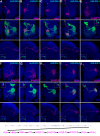A complete developmental sequence of a Drosophila neuronal lineage as revealed by twin-spot MARCM
- PMID: 20808769
- PMCID: PMC2927434
- DOI: 10.1371/journal.pbio.1000461
A complete developmental sequence of a Drosophila neuronal lineage as revealed by twin-spot MARCM
Abstract
Drosophila brains contain numerous neurons that form complex circuits. These neurons are derived in stereotyped patterns from a fixed number of progenitors, called neuroblasts, and identifying individual neurons made by a neuroblast facilitates the reconstruction of neural circuits. An improved MARCM (mosaic analysis with a repressible cell marker) technique, called twin-spot MARCM, allows one to label the sister clones derived from a common progenitor simultaneously in different colors. It enables identification of every single neuron in an extended neuronal lineage based on the order of neuron birth. Here we report the first example, to our knowledge, of complete lineage analysis among neurons derived from a common neuroblast that relay olfactory information from the antennal lobe (AL) to higher brain centers. By identifying the sequentially derived neurons, we found that the neuroblast serially makes 40 types of AL projection neurons (PNs). During embryogenesis, one PN with multi-glomerular innervation and 18 uniglomerular PNs targeting 17 glomeruli of the adult AL are born. Many more PNs of 22 additional types, including four types of polyglomerular PNs, derive after the neuroblast resumes dividing in early larvae. Although different offspring are generated in a rather arbitrary sequence, the birth order strictly dictates the fate of each post-mitotic neuron, including the fate of programmed cell death. Notably, the embryonic progenitor has an altered temporal identity following each self-renewing asymmetric cell division. After larval hatching, the same progenitor produces multiple neurons for each cell type, but the number of neurons for each type is tightly regulated. These observations substantiate the origin-dependent specification of neuron types. Sequencing neuronal lineages will not only unravel how a complex brain develops but also permit systematic identification of neuron types for detailed structure and function analysis of the brain.
Conflict of interest statement
The authors have declared that no competing interests exist.
Figures





Similar articles
-
Lineage analysis of Drosophila lateral antennal lobe neurons reveals notch-dependent binary temporal fate decisions.PLoS Biol. 2012;10(11):e1001425. doi: 10.1371/journal.pbio.1001425. Epub 2012 Nov 20. PLoS Biol. 2012. PMID: 23185131 Free PMC article.
-
Clonal analysis of Drosophila antennal lobe neurons: diverse neuronal architectures in the lateral neuroblast lineage.Development. 2008 Sep;135(17):2883-93. doi: 10.1242/dev.024380. Epub 2008 Jul 24. Development. 2008. PMID: 18653555
-
Drosophila olfactory local interneurons and projection neurons derive from a common neuroblast lineage specified by the empty spiracles gene.Neural Dev. 2008 Dec 3;3:33. doi: 10.1186/1749-8104-3-33. Neural Dev. 2008. PMID: 19055770 Free PMC article.
-
Birth time/order-dependent neuron type specification.Curr Opin Neurobiol. 2010 Feb;20(1):14-21. doi: 10.1016/j.conb.2009.10.017. Epub 2009 Nov 26. Curr Opin Neurobiol. 2010. PMID: 19944594 Free PMC article. Review.
-
[Progress on cell lineage analysis in Drosophila melanogaster].Yi Chuan. 2012 Jul;34(7):819-28. doi: 10.3724/sp.j.1005.2012.00819. Yi Chuan. 2012. PMID: 22805207 Review. Chinese.
Cited by
-
Individual Neurons Confined to Distinct Antennal-Lobe Tracts in the Heliothine Moth: Morphological Characteristics and Global Projection Patterns.Front Neuroanat. 2016 Oct 24;10:101. doi: 10.3389/fnana.2016.00101. eCollection 2016. Front Neuroanat. 2016. PMID: 27822181 Free PMC article.
-
Hacking brain development to test models of sensory coding.bioRxiv [Preprint]. 2023 Jan 26:2023.01.25.525425. doi: 10.1101/2023.01.25.525425. bioRxiv. 2023. PMID: 36747712 Free PMC article. Preprint.
-
A resource for the Drosophila antennal lobe provided by the connectome of glomerulus VA1v.Elife. 2018 Nov 1;7:e37550. doi: 10.7554/eLife.37550. Elife. 2018. PMID: 30382940 Free PMC article.
-
Toward a genetic dissection of cortical circuits in the mouse.Neuron. 2014 Sep 17;83(6):1284-302. doi: 10.1016/j.neuron.2014.08.041. Neuron. 2014. PMID: 25233312 Free PMC article. Review.
-
Origin of wiring specificity in an olfactory map revealed by neuron type-specific, time-lapse imaging of dendrite targeting.Elife. 2023 Mar 28;12:e85521. doi: 10.7554/eLife.85521. Elife. 2023. PMID: 36975203 Free PMC article.
References
-
- Young R. W. Cell differentiation in the retina of the mouse. Anat Rec. 1985;212:199–205. - PubMed
-
- Noctor S. C, Flint A. C, Weissman T. A, Dammerman R. S, Kriegstein A. R. Neurons derived from radial glial cells establish radial units in neocortex. Nature. 2001;409:714–720. - PubMed
-
- Urbach R, Schnabel R, Technau G. M. The pattern of neuroblast formation, mitotic domains and proneural gene expression during early brain development in Drosophila. Development. 2003;130:3589–3606. - PubMed
-
- Truman J. W, Bate M. Spatial and temporal patterns of neurogenesis in the central nervous system of Drosophila melanogaster. Dev Biol. 1988;125:145–157. - PubMed
Publication types
MeSH terms
Grants and funding
LinkOut - more resources
Full Text Sources
Molecular Biology Databases

